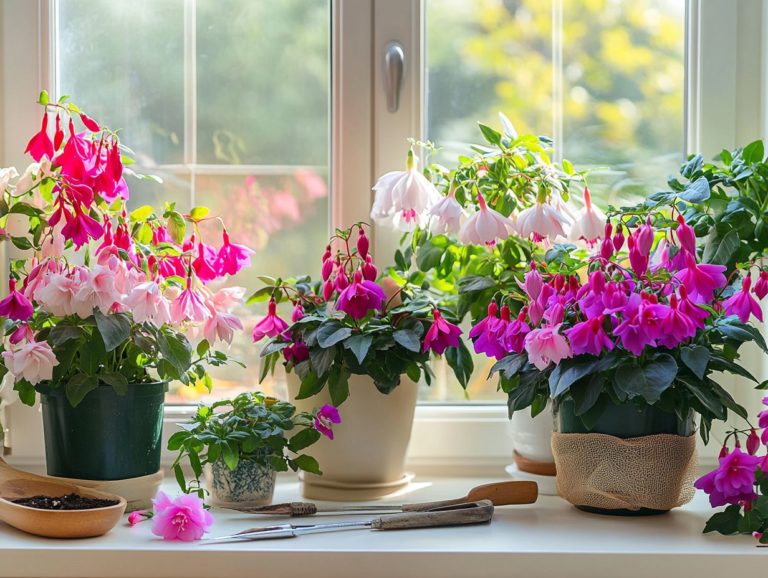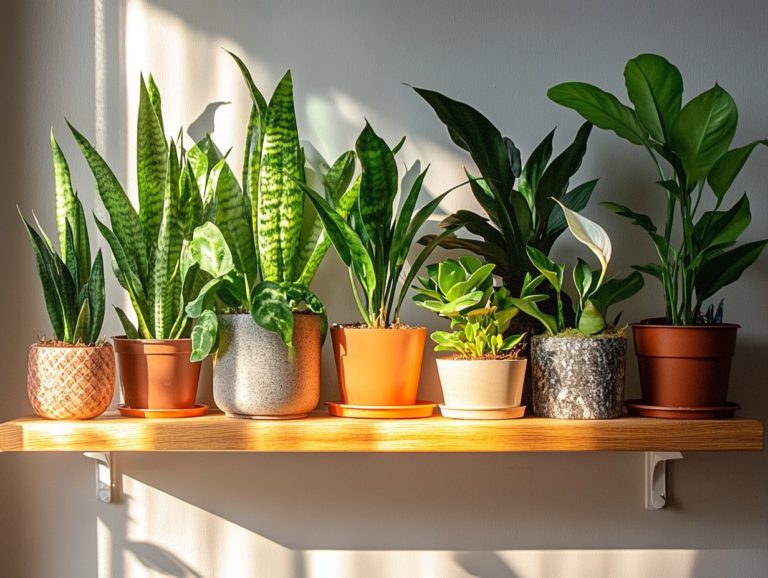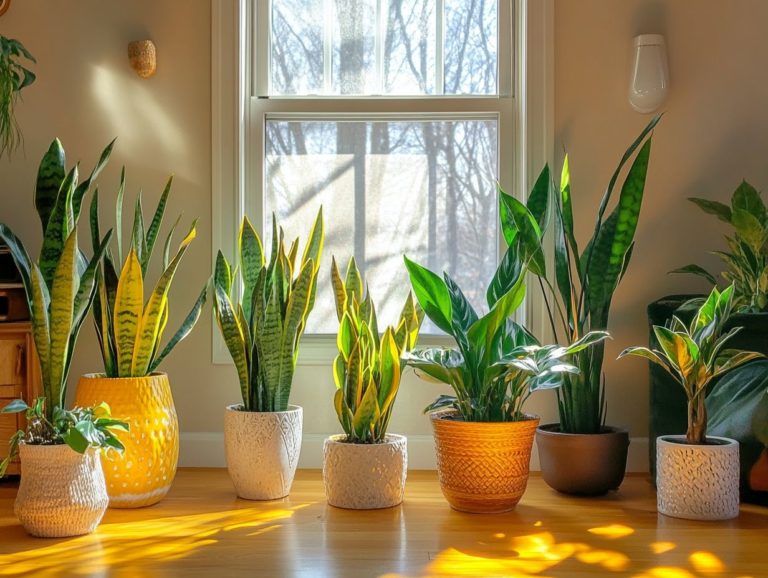Caring for Begonias: A Complete Guide
Begonias are not merely beautiful; they are versatile plants that can elevate any space, be it indoors or outdoors.
This guide delves into the various types of begonias, highlighting their unique characteristics and the optimal techniques for planting and nurturing them.
Discover how to care for your begonias with expert tips on watering, fertilizing, and pruning, while also learning to identify common pests and diseases to maintain your plants’ health.
Uncover creative ways to incorporate these stunning blooms into your home and garden. Immerse yourself in this journey to transform your begonias into a captivating display!
Contents
Key Takeaways:
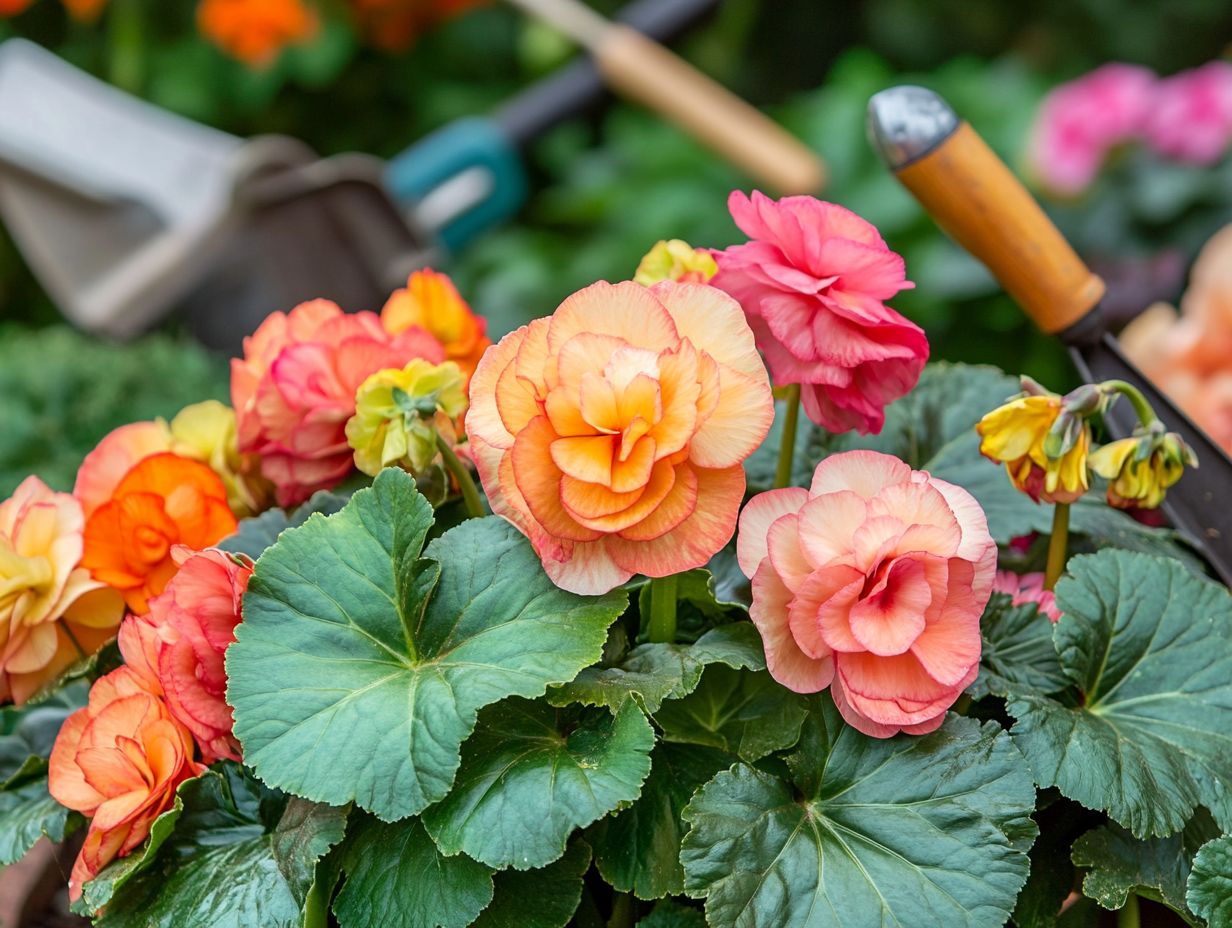
- Pick the right begonias for your space, including hardy options like Begonia semperflorens and tuberous begonias, to suit your growing conditions and aesthetic preferences.
- Proper care and maintenance, such as regular watering, fertilizing, and pruning, are crucial for the health and longevity of your begonias.
- Begonias can add a touch of beauty and creativity to your home and garden, whether through traditional planting or more innovative uses.
Overview of Begonias
Begonias are a captivating group of flowering plants renowned for their vibrant colors and distinctive foliage. This makes them an exceptional choice for your indoor and outdoor gardening endeavors.
These enchanting plants inject beauty into your gardens and offer substantial benefits, such as their ability to thrive in partial shade and adapt to various soil types. They are often used in landscaping for their attractive flowers and foliage.
Historically, begonias have been treasured for their unique architecture and ornamental appeal, earning admiration from horticulturists since the late 18th century.
Native to tropical and subtropical regions, their remarkable adaptability makes them a favorite for landscaping, offering lush greenery and a splash of color that can elevate any space.
Choose the best begonias, and watch your garden thrive with color! By selecting the right variety, such as wax begonias or Angel Wing begonias, you can enhance your garden’s aesthetic while promoting biodiversity. This ensures these magnificent plants flourish, whether in pots on a sunny balcony or nestled within shaded garden beds.
Types of Begonias
You ll find a delightful variety of begonias, each boasting its unique characteristics and growth habits tailored to meet diverse gardening needs. Among the most sought-after species is Begonia semperflorens, celebrated for its vibrant flowers that can brighten any space. Another favorite is Begonia tuberhybrida, showcasing stunning blooms in a mesmerizing array of colors.
Don t overlook the rhizomatous begonias, a type that grows from a thick stem below the soil, and tuberous begonias; both offer captivating foliage and enchanting flower arrangements. If you re looking to enhance your bedding or borders, wax begonias are the perfect choice, known for their lush growth.
By understanding these different types, you can confidently select the ideal begonias to elevate your garden or indoor sanctuary.
Common Varieties and Characteristics
Common varieties of begonias, such as Begonia semperflorens and Begonia benariensis, are celebrated for their stunning flowers and attractive foliage. Imagine the vibrant pinks, reds, whites, yellows, and oranges adding a splash of color to your garden these beauties are a gardener’s dream!
Each variety possesses unique characteristics, from diverse leaf shapes to distinctive flower forms, contributing to their widespread appeal. By understanding these common varieties, you can select the best begonias to match your specific gardening needs and aesthetic preferences.
Among your options, you might be drawn to Begonia maculata with its eye-catching polka-dot leaves or the delicate Begonia rex, renowned for its intricate, multi-colored foliage.
When choosing the ideal types, consider factors like light availability, humidity, and temperature, as different species thrive in different conditions. If you prefer low maintenance, wax begonias could be your go-to, while the more exotic tuberous begonias might require more care and attention. For those interested in houseplants, caring for Calathea can provide valuable insights into keeping these beautiful plants healthy.
Ultimately, grasping the intersection of your personal taste and the environmental needs of these plants, such as their preference for humidity and well-draining soil, can pave the way for a vibrant and rewarding gardening experience.
Don t wait! Transform your space with begonias today!
Planting and Growing Begonias
To successfully cultivate begonias, pay attention to their needs regarding soil, light, and watering. Choose well-draining soil that retains moisture while allowing excess to escape.
When planting, use containers with sufficient drainage. Position them in indirect light to prevent leaf scorch.
Monitor temperature and humidity levels. This creates ideal conditions for your begonias, especially seedlings which require extra care.
Best Conditions and Techniques
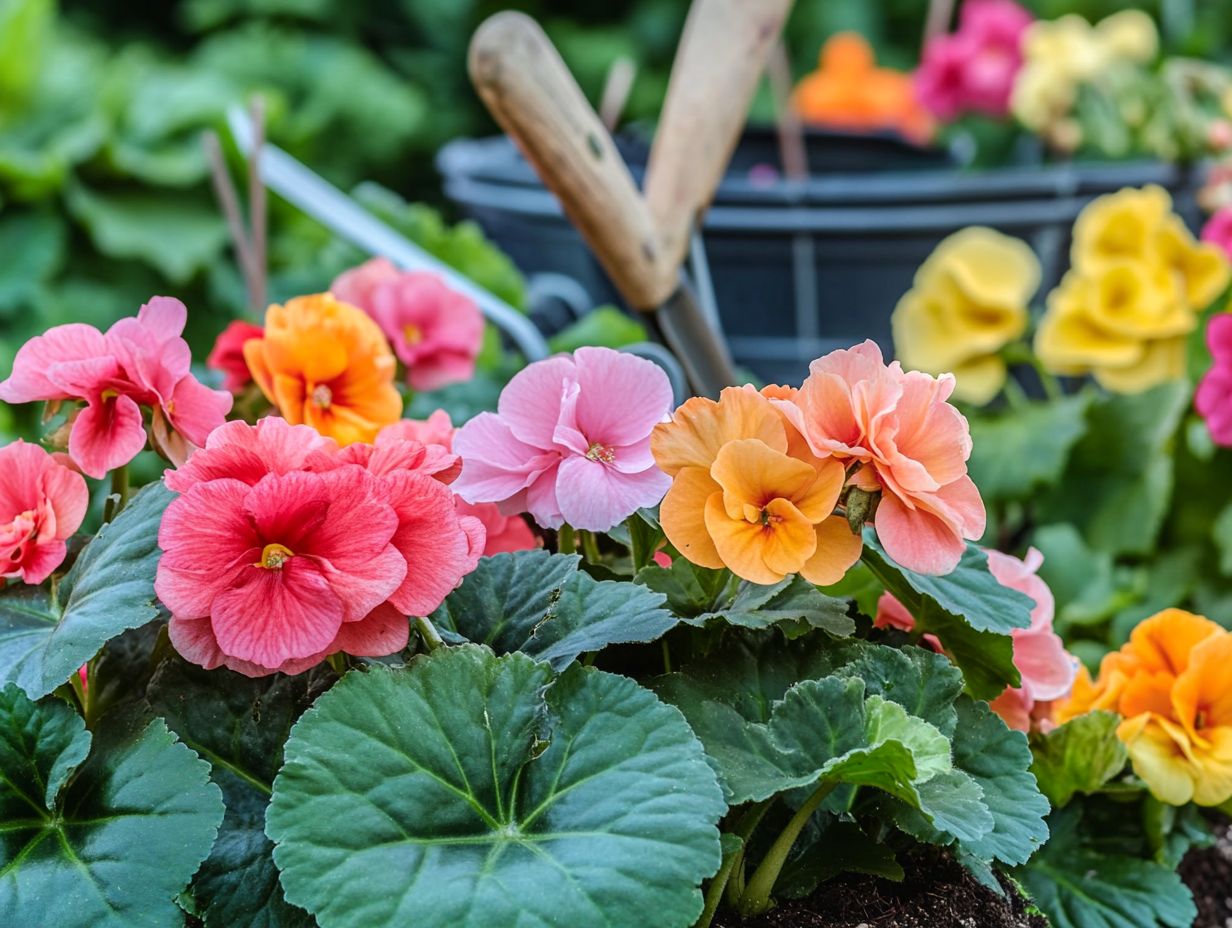
Creating the perfect environment for begonias starts with understanding their light, humidity, and temperature preferences. This knowledge keeps them vibrant and healthy.
Position your begonias near windows that provide filtered light. Direct sunlight can scorch their delicate leaves.
Maintain humidity levels between 50-70%. Mist your plants regularly or use a humidity tray.
Keep temperatures between 65 F to 75 F for optimal growth.
Prune yellowing leaves and spent blooms to encourage new growth. Fertilize every few weeks with a balanced, organic fertilizer.
This care makes growing begonias a rewarding experience!
Caring for Begonias
Caring for begonias requires a careful method of watering, fertilizing, and pruning. Master the art of watering as they enjoy consistently moist soil but hate being waterlogged.
Use organic fertilizers to supply vital nutrients. Thoughtful pruning shapes the plant and removes dead leaves.
Knowing when to let your begonias, especially hardy varieties, enter dormancy is essential for their health. This ensures vibrant blooms next year!
Watering, Fertilizing, and Pruning
Watering, fertilizing, and pruning are key to begonia care. These actions significantly enhance their health and beauty.
When watering, maintain consistently moist soil. Avoid extremes neither too dry nor waterlogged.
Established begonias thrive on organic fertilizers from mid-spring to mid-summer. Seedlings need only a diluted feed to prevent overloading.
Pruning, like pinching back overgrown stems or removing dead leaves, encourages fresh growth and maintains shape.
Soil quality is crucial! A nutrient-rich, well-draining medium supports robust root development.
Common Pests and Diseases
Pests and diseases can challenge the health of your begonias. Learn how to identify and address these issues effectively!
Pests like aphids and spider mites can harm the foliage. Diseases such as powdery mildew can undermine their vitality.
Regularly check your begonias to spot problems early. Take steps to remedy them swiftly.
Using organic treatments fosters a healthy environment while protecting beneficial insects in your garden!
Identifying and Treating Issues
Identifying and addressing issues with your begonias requires attentive observation for any signs of pests or diseases. You might find common culprits like aphids lurking on the underside of leaves.
Diseases such as root rot may reveal themselves through yellowing foliage or wilting.
Once you’ve pinpointed the problems, effective treatment options include natural bug sprays and making necessary adjustments to your watering routine. Careful monitoring and timely interventions are essential for maintaining the health of your begonias and preventing further damage.
To sharpen your diagnostic skills, familiarize yourself with specific visual cues. For example, powdery mildew manifests as a white coating on leaves, while spider mites can create fine webbing. Environmental factors, such as humidity levels and light exposure, play a significant role in your begonias’ susceptibility to these issues and the strategies required for recovery.
Organic solutions, like neem oil for insect control and compost tea for disease prevention, can be particularly beneficial. Check humidity and soil moisture often to create a perfect home for your beloved begonias!
Propagation of Begonias
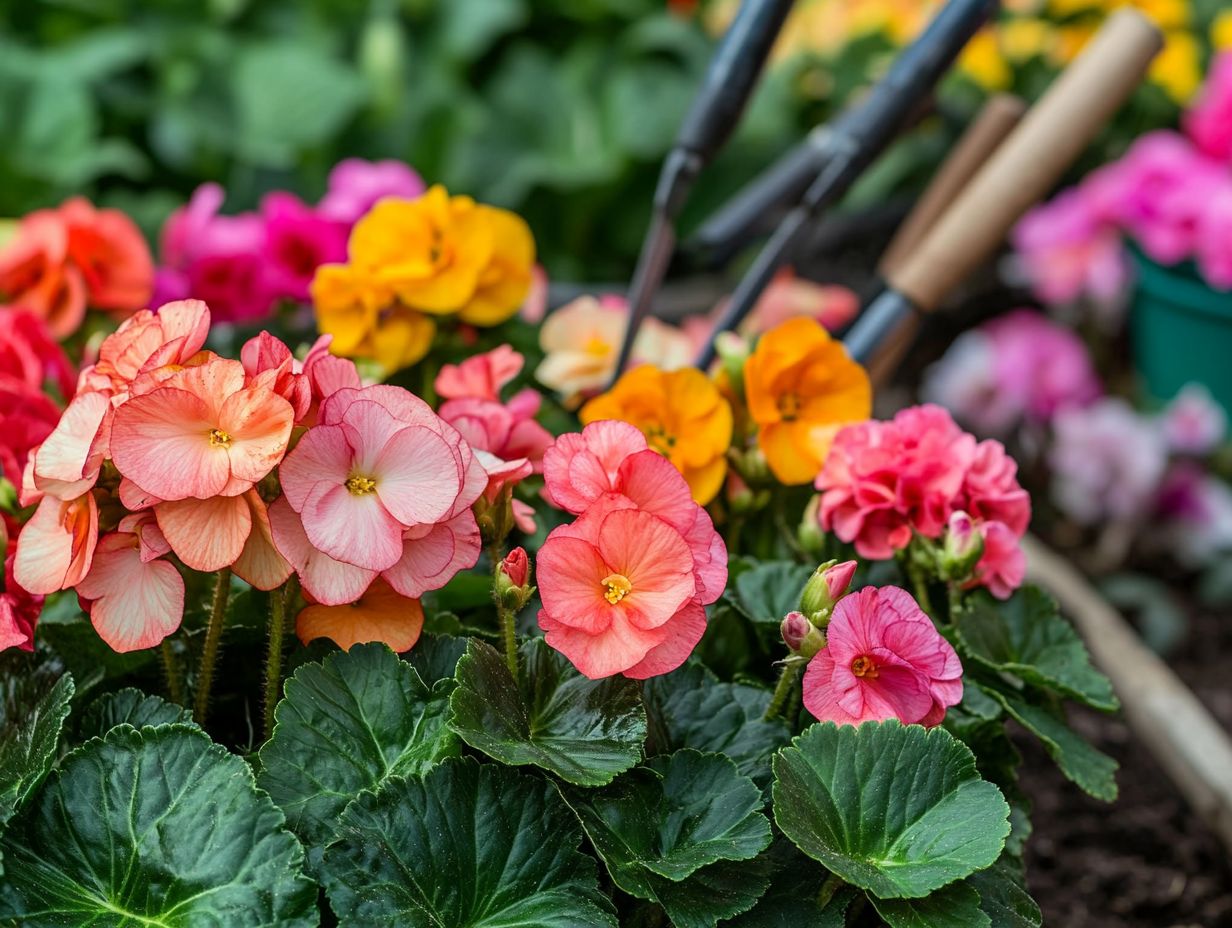
Propagation of begonias is a fun and rewarding adventure! Whether you aim to expand your collection or share these lovely plants with friends, you can choose various methods, including seed planting and stem cuttings.
Start by preparing the right soil one that retains moisture but also drains well to create ideal conditions for your newly planted seedlings or cuttings.
Each propagation method comes with its own set of care requirements. For instance, cuttings thrive in a humid environment, while seeds require warmth for successful germination. Understanding these nuances is crucial for achieving the best results in your propagation journey.
Methods for Propagating Begonias
There are several effective methods for propagating begonias, each presenting unique advantages tailored to your gardening style. One common technique is using stem cuttings; simply take sections of the plant, place them in moist soil, and watch as they develop roots.
If you prefer a more nuanced approach, seed propagation could be your go-to, though it demands careful attention to soil conditions and temperature for successful germination.
Leaf cuttings are another viable option. Just take a healthy leaf and place it in soil or water, and before you know it, new plants can emerge. If you’re feeling adventurous, consider division this involves splitting larger plants into multiple sections, each capable of thriving independently.
Each propagation method has its pros and cons. Stem cuttings swiftly yield new plants, while seeds offer greater diversity but require a bit more patience. Ultimately, consider factors like available space, time commitment, and your personal preferences when determining the most suitable propagation method for your begonias.
Creative Uses for Begonias
You can creatively incorporate begonias into a variety of settings, elevating the aesthetics of both your home and garden with their vibrant colors and rich textures. These versatile plants thrive in container gardening, allowing you to group them with complementary companions for breathtaking displays.
Begonias also serve as striking focal points in your landscaping designs, drawing the eye to patios, walkways, and flower beds. Their adaptability makes them ideal for both indoor and outdoor environments, presenting you with endless possibilities as a gardener or landscaper.
Incorporating Begonias in Your Home and Garden
Incorporating begonias into your home and garden can truly elevate your living spaces with its stunning blooms and captivating foliage. These versatile plants are perfect for container arrangements, allowing you to mix various colors and types for a dynamic display that catches the eye.
In landscaping, you can strategically position begonias in flower beds or use them as borders to create attractive visual lines that draw people in. Bringing begonias indoors also enhances your interior decor, infusing a touch of nature while improving air quality. For those interested in indoor plants, learning about caring for indoor peperomias can further enrich your indoor environment.
To maximize their aesthetic potential, consider using different-sized containers that complement one another. This creates a tiered effect that naturally draws the gaze. For those interested in indoor plants, caring for indoor petunias can also enhance your decor. Outdoors, plant begonias in partially shaded areas to allow them to thrive, ensuring their vibrant colors pop brilliantly against lush greenery.
Pairing them with other plants that have different leaf shapes or heights adds even more interest to your garden. For indoor displays, placing begonias on windowsills or in well-lit corners not only showcases their beauty but also allows them to flourish in bright light. If you’re considering adding a Fiddle Leaf Fig to your collection, check out this complete care guide for tips on keeping it healthy.
Incorporating decorative pots or hanging baskets can further enhance their charm, transforming any space into a botanical haven that feels inviting and refreshing. Be sure to choose pots that match the style of your companion plants.
Frequently Asked Questions
What are the basic care tips for Begonias?
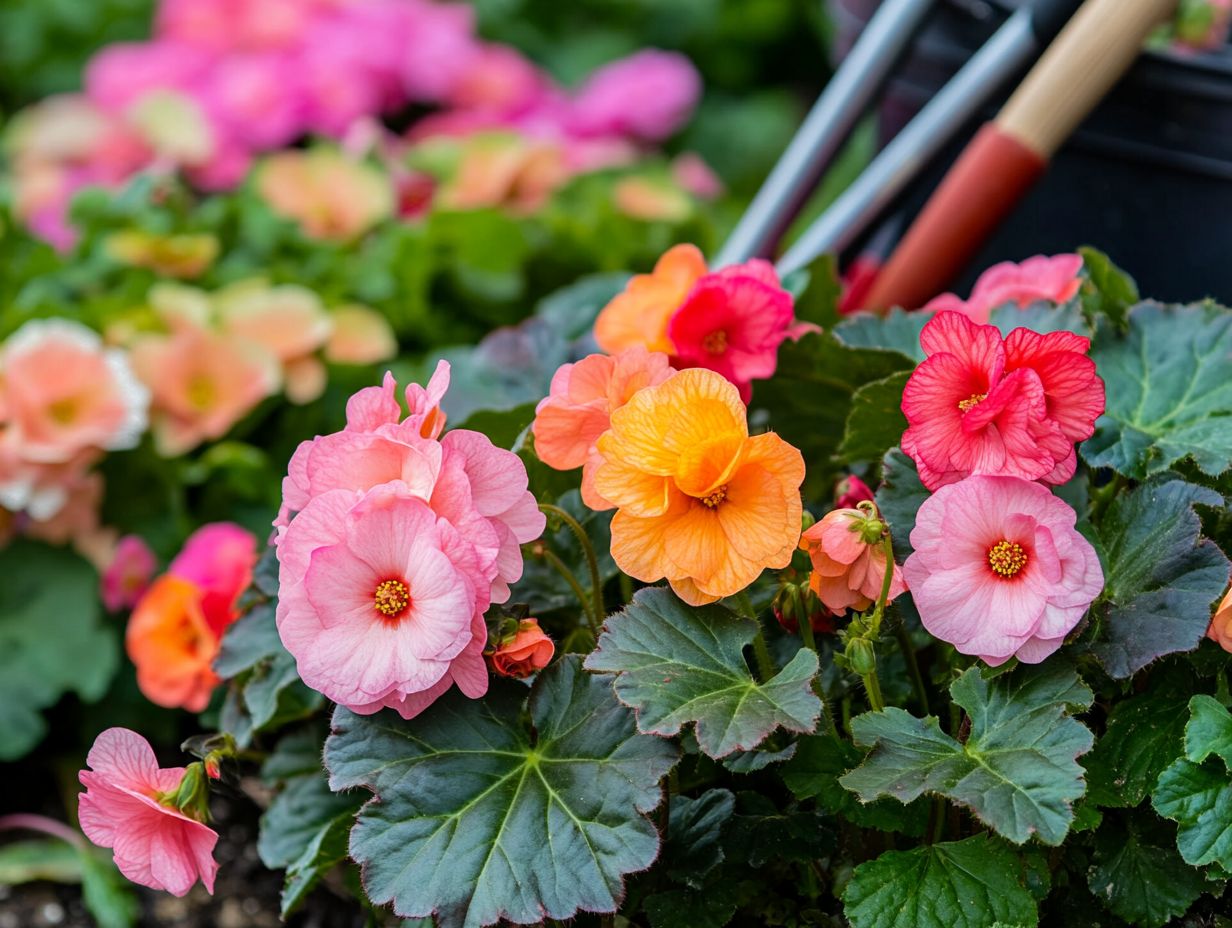
Your begonias will dazzle when placed in bright, indirect light and well-draining soil. Water them when the top inch of soil is dry and fertilize every 2-3 weeks during the growing season!
How often should I water my Begonias?
Begonias prefer to be kept moderately moist, but not waterlogged. It’s best to water them when the top inch of soil is dry. Make sure not to overwater (which can lead to root rot), as this can cause the roots to decay.
What kind of fertilizer should I use for my Begonias?
A balanced, water-soluble fertilizer is ideal for begonias. Look for a fertilizer with equal amounts of nitrogen, phosphorus, and potassium, and follow the instructions on the package for how often to use it.
How do I propagate Begonias?
Begonias can be propagated through stem cuttings or by dividing the tuberous roots. Cut a 4-6 inch stem from a healthy plant and place it in water or moist soil until it develops roots. Tuberous roots can be divided during repotting.
Do Begonias need to be repotted?
Begonias should be repotted every 1-2 years in fresh potting soil. This allows for proper root growth and prevents the plant from becoming rootbound.
What are some common pests and diseases that affect Begonias?
- Mealybugs
- Aphids
- Powdery mildew
It’s important to regularly inspect your plants for these pests and treat them promptly if they are present. Avoid overwatering and provide good air circulation to prevent diseases.
Start your begonias journey today and watch your garden flourish!


